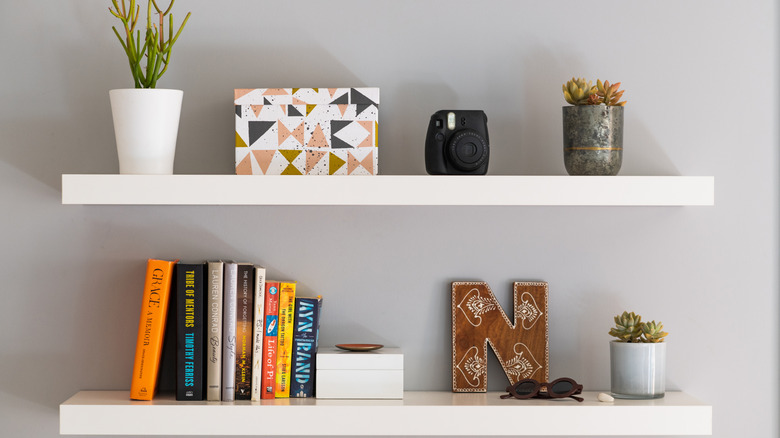How To Install Floating Shelves Without A Level
We may receive a commission on purchases made from links.
Floating shelves have always been a viable option for people seeking to add more storage in places where space may be limited. Installing them yourself is practical and often simple, especially if you're looking to upgrade your home on a budget. You can buy them online, like this QEEIG Floating Shelves set, or from your local home goods store, and have them up on your wall in an hour or less. But what if you realize at the last minute that you don't have a level to ensure that the shelves are ... well, level? Thankfully, there is an easy solution to sidestep this necessity. To ensure an even installation, you'll need a cardboard sheet, some string or twine, and a padlock.
It may sound like a weird combination, but it works. With this easy workaround, you're essentially going to use a right angle (that you'll draw) and the straight bottom edge of the cardboard sheet to create guidelines for the shelves. The string and padlock will enable you to fashion a mock plumb bob, which you'll use to confirm the guidelines' plumbness.
You probably already have a piece of cardboard somewhere around your home. If you don't have a padlock, items such as a metal spoon or 2 AA batteries will work. You'll also need a pencil, a box cutter (or scissors), a wall tack or small nail, and a DEKO PRO electric drill.
Draw floating shelf guidelines with a makeshift plumb bob
Start by pinpointing the locations of your studs using a stud finder, like this Mecurate 5-in1 Stud Finder with LCD Display, and then lightly mark them with a pencil. The goal is to determine if at least one mounting bracket can be secured by the stud; if not, you will need to use anchors for support. Find a cardboard sheet that measures at least 16-by-16 inches. Then use a ruler or other straight object to draw a perfect triangle with a 90-degree angle and two sides of equal length on the sheet. Cut out the triangle shape from the cardboard. Now, determine the perfect height for your floating shelves.
Then take an 18-inch piece of string and tie it around a tack. Next, insert the tack through the apex of the cardboard triangle and attach it to the wall such that the bottom of the triangle aligns with the desired shelf location. Tie the padlock to the bottom of the string. Next, rotate the triangle until the vertical pencil line is perfectly aligned with the makeshift plumb bob. Mark the shelf lines with a pencil, using the bottom of the cardboard as a guide. Take measurements to ensure adequate spacing between the shelves and then create guidelines for each one. Finally, mark the pilot hole spots.
Now, use a drill to create pilot holes and then secure the wall brackets to the holes with screws. Attach the internal brackets to the wall bracket you've just hung. Once all the shelf and wall brackets are in place, slide the shelf onto the bracket. Secure it in place by tightening the internal fasteners on its underside. Repeat these steps for all other shelves you're hanging.
